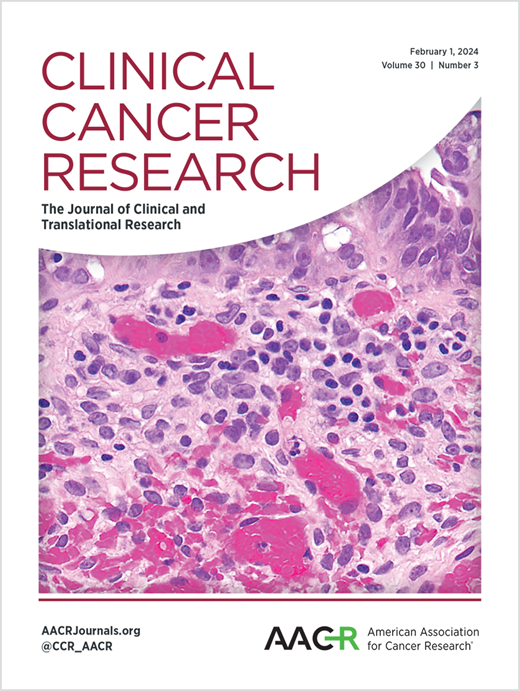在人乳头瘤病毒相关口咽癌中,循环肿瘤HPV-DNA与新辅助化疗的早期动态和反应性降级。
IF 10.2
1区 医学
Q1 ONCOLOGY
引用次数: 0
摘要
目的:人乳头瘤病毒相关(HPV+)口咽癌(OPC)与良好的生存率相关,但治疗会导致严重的毒性。需要改进的生物标志物来选择患者进行降级治疗。循环肿瘤HPV-DNA (ctHPV-DNA)是一种很有前途的非侵入性生物标志物,可用于衡量治疗反应和监测疾病复发。患者和方法进行了一项反应分层降级的前瞻性生物标志物临床试验。符合条件的非转移性HPV+ OPC患者接受新辅助化疗,然后通过经口机器人手术进行风险/反应分层降级,降级(化疗)放疗至50Gy,或标准放化疗至70Gy。深度缓解(>=50%肿瘤缩小/ RECIST v1.1)患者符合降级标准。在基线、新辅助化疗、放疗和后续治疗期间,使用HPV-SEQ检测血浆中的ctHPV-DNA。主要终点为ctHPV-DNA动力学与影像学反应的相关性。结果纳入46例符合条件的患者,共分析了488份ctHPV-DNA样本(平均每例11份)。中位随访30个月,5例复发(10.9%)。96%的可评估患者检测到基线ctHPV-DNA。一个周期新辅助治疗后快速早期ctHPV-DNA清除(>=95%减少)预测放射学深度反应(p=0.04)。治疗后3个月或更晚检测ctHPV-DNA与更差的无进展生存期和总生存期相关;p < 0.001。纵向ctHPV-DNA的敏感性、特异性和阳性、阴性预测值均为100%。从ctHPV-DNA阳性到发现复发的最长时间为25个月。结论在新辅助治疗期间,ctHPV-DNA的快速早期清除在预测治疗反应方面具有实用价值。治疗后检测到的ctHPV-DNA可预测疾病复发和生存恶化。本文章由计算机程序翻译,如有差异,请以英文原文为准。
Early dynamics of circulating tumor HPV-DNA with neoadjuvant chemotherapy and response-adapted de-escalation in human papillomavirus-associated oropharyngeal cancer.
PURPOSE
Human papillomavirus-associated (HPV+) oropharyngeal carcinoma (OPC) is associated with excellent survival, yet treatment drives substantial toxicity. Improved biomarkers are needed to select patients for de-escalated treatment. Circulating tumor HPV-DNA (ctHPV-DNA) represents a promising non-invasive biomarker to gauge treatment response and surveil for disease recurrence.
PATIENTS AND METHODS
A prospective biomarker clinical trial of response-stratified de-escalation was conducted. Eligible patients with non-metastatic HPV+ OPC received neoadjuvant chemotherapy followed by risk/response-stratified de-escalation with transoral robotic surgery, de-escalated (chemo)radiation to 50Gy, or standard chemoradiation to 70Gy. Deep response (>=50% tumor shrinkage per RECIST v1.1) qualified patients for de-escalation. ctHPV-DNA was measured using HPV-SEQ in plasma at baseline, during neoadjuvant chemotherapy, radiation, and following treatment. Primary endpoint was correlation of ctHPV-DNA kinetics and radiographic response.
RESULTS
Forty-six eligible patients were enrolled, and 488 ctHPV-DNA samples were analyzed (median 11 per patient). Median follow-up was 30 months, and five recurrences were observed (10.9%). Baseline ctHPV-DNA was detected in 96% of evaluable patients. Rapid early ctHPV-DNA clearance after one cycle of neoadjuvant therapy (>=95% reduction) predicted radiographic deep response (p=0.04). Detection of ctHPV-DNA 3 months or later after treatment was associated with worse progression free and overall survival; p<0.001. Sensitivity, specificity, positive and negative predictive value of longitudinal ctHPV-DNA was 100%. The longest lead-time from positive ctHPV-DNA to detection of recurrent disease was 25 months.
CONCLUSIONS
Rapid early clearance of ctHPV-DNA during neoadjuvant therapy demonstrates utility in predicting response to treatment. Detectable ctHPV-DNA following treatment is predictive of both disease recurrence and worse survival.
求助全文
通过发布文献求助,成功后即可免费获取论文全文。
去求助
来源期刊

Clinical Cancer Research
医学-肿瘤学
CiteScore
20.10
自引率
1.70%
发文量
1207
审稿时长
2.1 months
期刊介绍:
Clinical Cancer Research is a journal focusing on groundbreaking research in cancer, specifically in the areas where the laboratory and the clinic intersect. Our primary interest lies in clinical trials that investigate novel treatments, accompanied by research on pharmacology, molecular alterations, and biomarkers that can predict response or resistance to these treatments. Furthermore, we prioritize laboratory and animal studies that explore new drugs and targeted agents with the potential to advance to clinical trials. We also encourage research on targetable mechanisms of cancer development, progression, and metastasis.
 求助内容:
求助内容: 应助结果提醒方式:
应助结果提醒方式:


